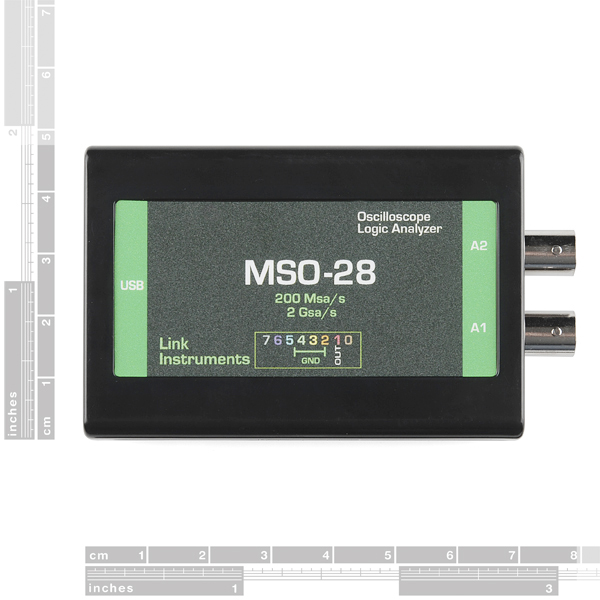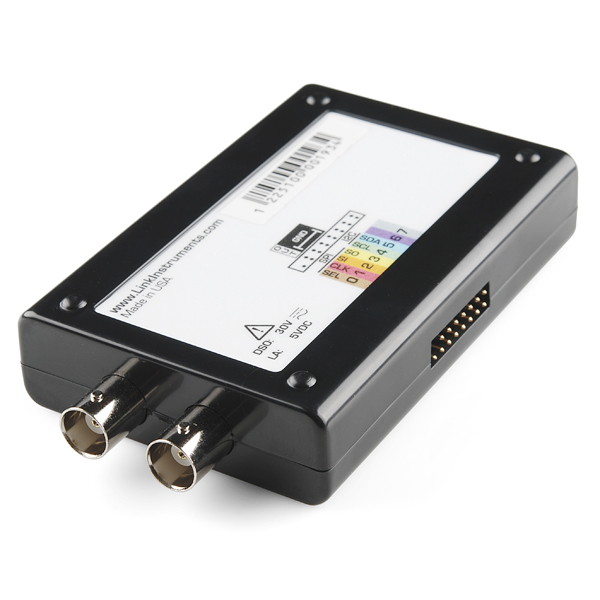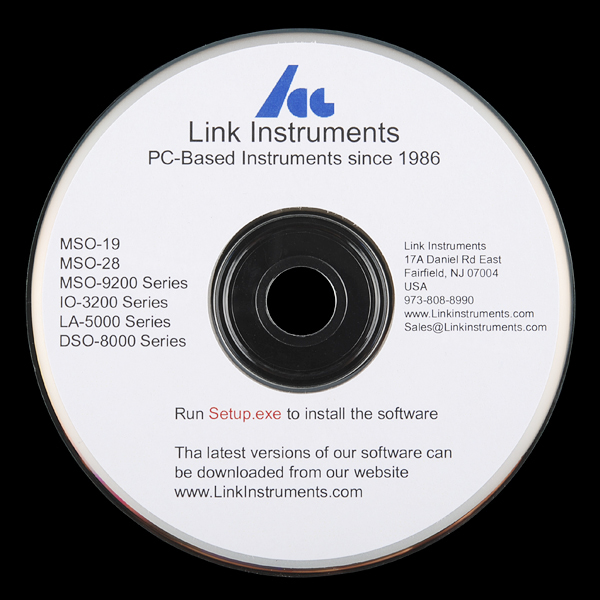USB Oscilloscope - MSO-28
Who needs a whole bag full of instruments just to do some debugging? Why can't your logic analyzer and your DSO be the same box? Well this new tool from Link instruments solves that problem. The MSO-28 is a 2GSa/s oscilloscope as well as a 200MSa/s logic analyzer. This combination does more than save space, though, because with all ten channels being sampled during the same clock you get accurate time correlation between logic and o-scope events. All channels on the instrument can be viewed simultaneously using the included software. Simply plug in the device, install the drivers and you're ready to do some serious troubleshooting. Also, at just 2.5oz, it's small and light enough to pack in your laptop case or tool bag.
The MSO-28 offers several different triggering options including adjustable rising and falling edge triggers, pulse width, logic triggers, even I2C and SPI trigger words. Also, because of the large buffer size and quick processor in the MSO-28, the speed of your computer won't significantly effect the performance of your instrument.
- MSO-28 Oscilloscope Logic Analyzer
- Software and Drivers CD
- x1/x10 Oscilloscope Probes with Test Hook Attachments
- 8- Pin Wiring Harness
- EZ Hook Test Probes
- USB mini-B Cable
- Advanced Triggering: Multiple Oscilloscope Triggers, Logic Trigger Words, I2C and SPI
- High Speed Sampling: 200MSa single shot sample rate and 60MHz bandwidth
- Display and decode SPI and I2C serial bus protocols as well as trigger on them.
- FFT Spectrum Analyzer
- Small and Lightweight
- USB Powered
- 4.0" x 2.4" x 0.8" (102mm x 61mm x 20mm)
USB Oscilloscope - MSO-28 Product Help and Resources
Core Skill: Electrical Prototyping
If it requires power, you need to know how much, what all the pins do, and how to hook it up. You may need to reference datasheets, schematics, and know the ins and outs of electronics.
Skill Level: Experienced - You will need to consult a datasheet for calculations to determine a components output format, linearity, and do a little math to get what you need. You will be using a datasheet or schematic beyond basic pinouts.
See all skill levels
Comments
Looking for answers to technical questions?
We welcome your comments and suggestions below. However, if you are looking for solutions to technical questions please see our Technical Assistance page.
Customer Reviews
4 out of 5
Based on 1 ratings:
0 of 1 found this helpful:
Solid SW/USB O-Scope
Using this tool for development (bench work) and remote data collection down in production (trouble shooting). Running on Windows boxes, but you can get the SW to run on Linux and the Mac as well. It is very useful being able to dump a trace and then process it using Mathematica or Python without transferring the file. This makes it a very flexible tool for development. Previously, i was running around with thumbdrives and scopes. Now i can just bring the laptop and all my tools are in one place. The one downside is the GUI delay and refresh rate makes it a little hard to set the trigger. I would feel more comfortable with physical knobs, but that's just me being old and not flexible. So it's a preference issue. Once it was triggering, it was fine. Once it's set, you can save the setting and never fiddle with it again. Very happy with my purchase.





So I don't have the MSO-28, I have the MSO-19 which is approximately the same except it is one analog channel. This meter is a waste of money. Now I'm not saying that it doesn't work because it does and it does work as a scope. What I am saying is that it is ridiculously overpriced when you can get a Sigilent scope for the same price. Some measurements I tested on my scope: 60MHz analog bandwidth!! Laughable. 60MHz/200MSa/s = 3 samples per waveform!! Really this scope is completely useless over about 20MHz. A spec not given is the capture rate. I clocked mine at a whopping 6 waveforms per second. You read that correctly, not 6,000. Not 60,000. 6. Also, 1GSa/s is only in repetitive mode, not real-time capture. That is limited to 200MSa/s. The serial decode doesn't really work. It sort of does, but gets hung up and isn't reliable to say the least. Compare all of this to the SDS1202X-E: https://store.siglentamerica.com/product/sds1102x-e/ Do what I should have done and buy a real scope.
This now supports OS-X and Linux. But check first, as this may only apply to some serial numbers (hardware versions).
Sigh, yet another USB scope that's windows only...
Yeah, I was pulling my wallet out... and then read your comment.
Sigh
I'd love something like this for the Mac.
Ooh. Me too.
Have recently tested this and several others, all of them so far have worked reasonably well with a Win7 x64 VM running under Parallels (MacBookPro, MacPro). Screen refresh is approx 15 to 20% slower than native at 1920x1080x32-60 but acceptable for the most part. Worst case, a cheapo AMD APU or Core i3/i5 ITX system works, as would BootCramps.
Disclaimer: I ended up selecting the QuantAsylum QA100 over the MSO-19 et al, for price/performance ratio, and the larger (2M) sample buffer.. If you only needed the LA part though, within this range the LogicPort would be your best bet. This is for portable/small bench use... as light as they are I still don't carry the Rigol or Tek in my travel pack LOL
Unfortunately, I have neither a Windows installation disk nor VMWare Fusion / Parallels. With Windows 7 running around $150 and Parallels around $50, that adds $200 to the price of the scope. And that's starting to get into the low end of stand-alone unit prices which would actually be much more convenient on my workbench.
Linux has Wine, so you could use it that way...
A program like this can access hardware in two ways. Via a custom driver, or by directly communicating with the device. WINE doesn't support either method. It will certainly run the application - just long enough for it to advise you the device isn't connected.
Is there any open linux software that works with this hardware?
No.
I've contacted Link Instruments requesting some, and pointed them back here, but there's currently no software that works with this hardware.
Osqoop is open-source oscilloscope software which could be made to work with this hardware if a driver was written.
Anyone here had experience with Bitscope products? They claim Windows, Linux and Mac versions. they seem competitively priced at around $300.. Peter B.
Bitscope was once fully open source, but the newer designs aren't open. They do support all three OSes and there is source for some parts.
Make a video of it in action so we can see it working.
Better yet, how about a scope tutorial?
A scope tutorial is in the works.
yikes. you guys aren't gonna be happy about tomorrow then :-)
I'll see if we can do a scope and analyzer tutorial. but it won't happen just yet...
I hear a According to Pete coming on...
I need these for Mac. Is there any way to run this in mac?
Has anyone been able to get a hold of the 64 bit software for windows 7?
Those are sexy EZ Hook probes. Does anyone know where one could get a rainbow pack like that? They would go great with my Saleae Logic.
Found them: http://www.digikey.com/product-detail/en/XKM-S/461-1012-ND/528233
Same brand, same colors. SparkFun should sell them...
Can we get a teardown picture of this? I want to see what FPGA/ASIC setup they're using for it.
Is a Silabs F326 USBXpress -> Lattice MachXO 2280 CPLD --> KAD5610P-12 125MSPS dual 10bit ADC